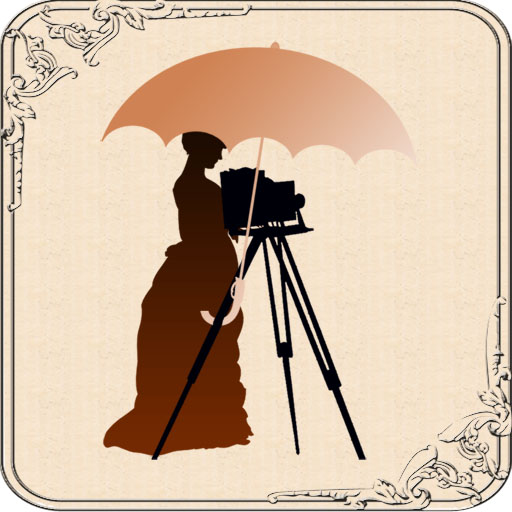Notes
A selection of photos by The Roche Studio, and also one by the Loomis-Roche studio:
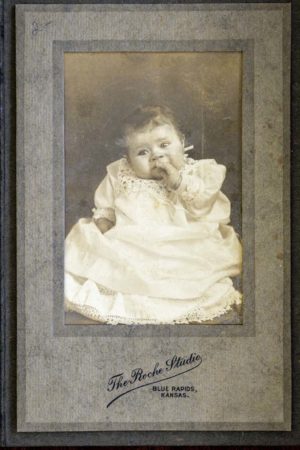
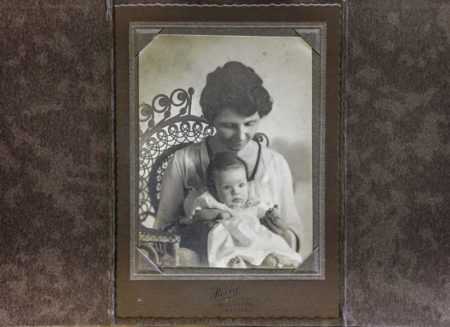



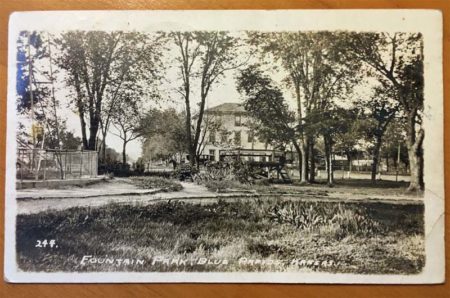

Advertising for the Roche Studio:



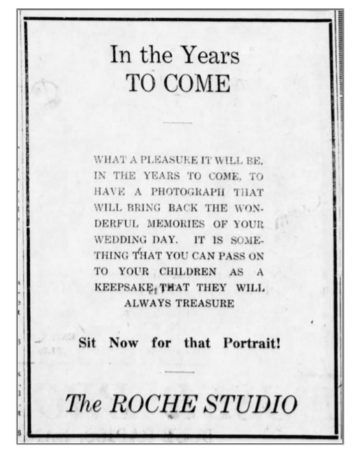
Other:


Lifeline
Note: The lifelines below include all 18 women who were active as professional photographers in Blue Rapids, Kansas. Birth/Death dates are included if known; the orange “active” bar includes their dates working as photographers in Blue Rapids only. As indicated in the episodes, some of them continued photography after leaving Blue Rapids, but that is not reflected in the lifelines below.
A “*” before a woman’s name indicates she ran a studio in Blue Rapids.
Recommended Links
- Tom Parker links
- Online research sites used for today’s episode
- Family Search website has U.S. Federal Census and more; free account required – Visit
- Ancestry.com (census records, city directories, and more; paid account required – Visit
- Geneologybank.com has a selection of digitized newspapers from the United States; paid account required – Visit
- Newspapers.com has a selection of digitized newspapers from the United States; paid account required – Visit
- Newspaperarchives.com has a selection of digitized newspapers from the United States; paid account required – Visit
Transcript
You’re listening to Photographs, Pistols, and Parasols.
Support for this project is provided by listeners like you. Visit my website at p3photographers “dot” net for ideas on how you, too, can become a supporter of the project.
Welcome to Photographs, Pistols & Parasols, the podcast where we celebrate early women artisan photographers.
I’m your host, Lee McIntyre.
Today we’re going to follow the story of Daisy Roche and see what happens once she opens her own photography studio in Blue Rapids, Kansas.
For more information about any of the women discussed in today’s episode, visit my website at p3photographers.net. That’s letter “p”, number “3”, photographers “dot” net.
*****
September 3, 1903.
We’re back in Blue Rapids, Kansas, and we are reading a notice in the Blue Rapids Times.
The notice says,
Miss Durkee has sold her art gallery to Miss Daisy Roche, who for some time has been her assistant in the gallery. Possession will be given September 14th. Miss Durkee will go to Kansas City to enter a large studio for the purpose of continuing her studies in art. Miss Durkee has made many friends here, who regret to see her leave us.
Now, I think I’d better recap some of the material that I covered in the last episode to clarify just who Miss Durkee and Miss Roche are.
You might recall from the last episode that in 1898, a photography studio was opened in Blue Rapids by a woman named Gertrude Haun.
She’s initially assisted by a woman named Gertrude Axtell, but later is assisted by a woman named Florence Durkee.
Florence Durkee is actually usually called Kittie by people there in Blue Rapids.
And in 1902, Kittie Durkee buys the studio from Gertrude Haun.
Now competing with that studio, starting in 1898 when Gertrude Haun opens it, is something called the Cottage Studio, which is run by a series of women, first the Millers (who are a husband and wife), and then Mrs McAllister, and then Miss Schrebe.
But by August of 1903, the Cottage Studio is run by a man named D.L. Reed.
So when Daisy Roche opens her studio, the Roche studio in September of 1903, she’s actually unique among the other women photographers that I’ve talked about, because for the first time she’s the only woman running a studio there in Blue Rapids.
But she’s not the only studio; as I said, there’s at least one more, run by D.L. Reed.
Daisy Roche is also unique because she runs the Roche Studio for a long time, opening it in 1903, and then closing it sometime in the 1950s.
I don’t have an exact date for when that studio closed, unfortunately.
But in talking with locals in Blue Rapids today, many of them remember the Roche Studio from when they were kids in the 1950s.
Now, over the decades, the Roche Studio has numerous ads in the newspaper.
The Blue Rapids Times has been digitized up to about 1925, and so I have several examples that are later on than any than any of the ones I talked about last time, because last time those studios all closed by 1903.
But we have one from the WWI period, where photographers are advertising to send pictures to the boys overseas.
It is a beautiful ad that was found in the Blue Rapids Historical Society archive.
It’s a beautiful poster [in color] that says “Our soldier boys want photos of you and your family, have them made now at the Roche Studio.”
There are also Christmas themed ads in the 1920s, like “Christmas time is Picture Time,” from 1924.
There’s one from 1925 that talks about wedding photos, encouraging wedding couples to come in to sit for their portrait.
It’s interesting to read that, because when we look at wedding photos from the 21st century, we have a different concept of having more of a candid [taken], or having photos taken at the church, or at the reception.
But in the late 19th and early 20th century, it was more common for the wedding couples to actually go to the studio dressed in their finery to get their picture taken.
I love how the ad that the Roche studio has talks about how you should get your picture taken because years from now you’re going to love having a memory of your wedding.
There’s also a great ad from 1925, where the Roche Studio promises “Individuality in Photography — we interpret your individuality, not ours!”
******
Now, as much as that notice in 1903 says that they are going to miss MIss Durkee — and I think they probably did — Miss Roche was actually quite popular even before she started her studio.
She was very active in all of the social events in town, starting with when she was a librarian in the late 1890s, and going forward into the period when she started to become a photographer.
Some of those social events in town are quite interesting, because there were card parties … there were other games like Crokinole, which I never heard of.
It’s like a tabletop shuffleboard thing, and there’s actually a World Championship of that in Toronto in June.
It happens every year.
But just seeing all of the photographers that I’ve talked about, they’re actually all intertwined in these social events.
One of the main things that happens when women get married, of course, is there all these wedding showers.
And Miss Roche actually is very active giving the kitchen shower to Gertrude Haun, that first photographer, when she gets married in 1903
And then in 1904, when Gertrude Hubbard, that assistant to Gertrude Hahn, when she gets married to a dentist, Dr. Gilson … well, she is given a whole series of showers:
- there’s a “heart theme” shower given by Daisy Roche
- there’s a “kitchen shower” are given by another woman
- there’s even what’s called a “soap shower”.
And as the notice in the paper talks about the soap shower, it says it was “appropriately given on wash day”.
Because, you see, a soap shower ties a bunch of ribbons to bunch of cakes of soap, and then strings them throughout the house.
The bride-to-be takes the ends of the ribbons and has to follow the ribbon to the cake of soap.
And when she gets to it, it’s for washing whatever would be appropriate in that particular room.
Interesting idea — I’ve not heard of a soap shower before.
But anyway, again, Daisy Roche is just a really popular person in town, and it’s really not surprising that she’s able to be very successful with her photography business, because she’s also a very good photographer.
Now, she has a number of assistants over the years, including a woman named Miss Lila Leopard.
In 1911 Lila Leopard, though, has a slight accident.
And there’s a notice in the paper that she’s home sick because she has poisoning stains on her arms.
That’s just a good reminder that in 1911 we’re not talking about instant photography or digital photography, we’re talking about photography that used an awful lot of very dangerous chemicals.
But I’m happy to report that Lila Leopard does recover.
She goes on to art school in Chicago in 1912.
She actually gets a position in a photo studio in Chicago, where she works for several years until she gets married in the 1920s … and then I lost track of her.
Anyway, Daisy Roche has other women assisting her, people like Florence Greer, who works as her assistant, and is actively going to the photography conventions with Miss Roche during the early 1900s.
There is actually a social note on that involves Miss Florence Greer and MIss Daisy Roche and that Gertrude Hubbard Gilson.
When she and her husband celebrate their 5th wedding anniversary, her sister-in-law, Dr. Elnora Gilson-Whitmore, gives a big party for them,
And Daisy Roche and Florence Greer are described as being the ones responsible for the punch bowl.
Which is kind of an interesting little note to have in the social notice.
But anyway, Daisy Roche is really quite popular there in town, both socially and also with her photo studio.
Now, although she did have a lot of assistants over the years, mostly she was the sole owner of the Roche Studio.
But there’s one major exception to that, that happens in 1908.
If you remember, I just mentioned Gertrude Axtell, she was the first assistant for Gertrude Haun back in 1898.
Gertrude Axel never seems to go off and start her own studio.
But in 1903 she gets married to a man named Guy Loomis.
Guy Loomis is not a photographer when they get married.
But in 1908 he decides to set up his own photography studio in Blue Rapids, effectively becoming a competitor to Daisy Roche.
But then a few months later, there’s a notice in the paper that Daisy Roche and Guy Loomis are joining forces, and their studios are now going to be called the Loomis-Roche studio.
Over the next couple of years they hire some assistants, including a Miss Geneva Moxley, who looks after things when they’re off at the photography conventions.
But by 1910, though, the Loomis-Roche partnership is dissolved.
Now I do have a postcard that was done by that studio that I will share on the website.
But there are not a lot of materials that exist from that Loomis-Roche partnership.
Once the partnership dissolves, Guy Loomis and his wife, Gertrude, actually leave Blue Rapids.
I followed their trail for a little bit, and they never really do photography again.
But Daisy Roche stays put [in Blue Rapids], and after the Loomis-Roche Studio folds, she just re-opens the Roche studio and continues on, on her own.
Now by the 1940s she’s been running that studio for a long time, mostly on her own.
And what was interesting was going to a Blue Rapids last year and talking to people in town who remembered the Roche Studio, but what they remembered was that it was run by two women — not just Daisy Roche, but Daisy and her sister, Emma.
As it turns out, her sister Emma was initially not a photographer; she had gotten married early to a man named Joseph Vaughn.
But he died before 1911.
There’s a social notice in the paper in Blue Rapids in 1915 that she’s now living in Marshall, Missouri, where she’s running a photography studio — and she has also just gotten married to a man named Alonzo Elmer Collis.
Both she and her new husband are photographers in Marshall, Missouri, and the notice says they’re going to continue to operate a photography studio together.
As far as I can tell, they continue to do that at least until the early 1930s.
But something clearly happens in the 1930s to their marriage, because in the early 1940s we find Emma Collis back in Blue Rapids, living and working with her sister Daisy Roche at the Roche Studio.
Now there’s a really kind of sweet story told [to me] by a [current] resident of Blue Rapids, who remembers going to the Roche Studio as a child in the 1950s.
As she recalls it, she was maybe five years old — maybe a little less — and she really didn’t want to smile.
Her mother was furious because she wanted a nice picture of the family, and here was her little daughter not willing to smile.
But suddenly into the room walked what the woman remembers thinking as a little girl was a very old man.
Although, of course, to a little five year-old girl, “really old” could be anything over 30! 😉
At the time, she had the impression that the man was perhaps the photographer’s father, the photographer, of course, being Daisy or Emma Roche.
But in looking at the records, we realize that Daisy and Emma’s father had died many years before, so that might have been maybe their brother, or something, who was living there.
Anyway when the man walked into the room, he was in just his bathrobe.
And this woman remembers that she just started laughing as a little girl, which made for a great photo — which she still has — but it made her mother so furious, because she was being so rude, laughing at this man in the bathrobe.
Anyway, it was great to be able to talk to someone who actually remembered going into the Roche Studio and having their photo taken.
At some point the Roche Studio becomes the only photography studio in town, and it’s certainly the only one that people today remember there ever being there.
Unfortunately, since I have not had an opportunity to sit down with all the non-digitized editions of the newspaper to try to find notices to find out when the Roche Studio becomes the only studio, I can’t tell you exactly when that was,.
But I do know that the Roche Studio was still in operation well into the 1950s.
The Roche sisters themselves don’t actually die until the 1960s.
What’s really fun for me in Blue Rapids is that, similar to Lowell, Massachusetts, which I talked about a couple of episodes ago, we see so many of the multi-threaded narratives that run through the lives and the stories and the careers of these early women photographers.
I mean,
… there are single women who do professional photography before they get married;
… there are married couples who are running studios together;
… there’s a widow who takes it up after husband dies (but actually it’s long after her husband dies, and he wasn’t a photographer to begin with);
… we also see an example of a partnership between a man and woman who are not related in any way but are running a studio together;
… and of course we have an example of family members running the studio together, the two Roche sisters.
We also have examples of all the different kinds of artisan photography that we know that artisan photographers produced: portrait photography, landscape photography, newspaper photography, yearbooks; advertisements; and we also see great examples of that entrepreneurial spirit of the early women artisan photographers with their thematic, creative ads.
As I said, we have examples of all of those things here in Blue Rapids.
Now Blue Rapids is really just one of the many towns in Kansas that I’ve been exploring to uncover what turns out to be a really rich history of early women artisan photographers.
Of the hundreds of photographers that I’ve gathered information on to date, I’d say at least a third of them come from Kansas.
Now I talked about some of the women from Beloit back in Season One, and as I mentioned at that time I’m not quite sure yet why there were so many women I find in Kansas compared to everywhere else.
It could be just an accident of the material being more accessible … it could be an accident of restrictions on women owning property and things that are a little more flexible in Kansas … I’m not quite sure, I’m still trying to investigate that.
We could easily spend the rest of the year looking at women from Kansas alone.
I mean, Blue Rapids has the highest concentration of women in Kansas of all the other towns, but certainly some of the other towns have a lot as well, like Beloit.
Blue Rapids is really spectacular, though, in that 18 women — in a population of 1000 – is really quite extraordinary.
But I don’t want to spend all of our time in Kansas this season.
I mean, Season Two, I’ve said, is really all about travel.
So next time I want to travel on a little further west.
But, to borrow a little bit of the sentiment from Dorothy Gale in the Wizard of Oz, in terms of the history of early women photographers, I think there really is no place like Kansas.
So rest assured, we’re gonna find our way back to Kansas sometime soon.
****
One final special note…
The Roche Studio house, the place where Daisy Roche, and later Emma Roche [Collis] both worked and lived in Blue Rapids still stands.
It is no longer a photography studio.
But thanks to the wonderful gentleman who now owns that house, who was willing to let the Blue Rapids Historical Society bring a small group of us in to see where Daisy Roche and Emma Roche [Collis] actually had their studio.
It’s the place where that woman who remembers being a small child — with the man coming in the room and her laughing — well it’s the place where she actually went to the Roche studio [as a kid].
And that was so wonderful to see.
And so I really want to thank that gentleman, and also the wonderful people at the Historical Society who made so much of this possible.
Special thanks in particular to Lori Parker for making all the arrangements that day, including not only the field trip to the old Roche Studio building, but also to the cemetery to pay our respects to Daisy Roche, her sister Emma Roche Collis, and their family.
It was thanks to that visit that we were later able to track the family back to before their time in Blue Rapids; as it turns out they were from Canada.
But since Daisy and her sister, Emma, were the only photographers from the family, so information about the rest of the Roche family will have to wait for another day.
As I did in the last episode, I really want to thank everyone there in Blue Rapids who has been helping with this project.
In addition to Lori, I’d like to also say a special thanks to Annette, Nancy and Pat, as well as everyone else that we’ve talked with at the Blue Rapids Historical Society and elsewhere in town.
And many, many thanks also to Tom Parker, the local photographer from Blue Rapids who took pictures a lot of materials from the Blue Rapids Historical Society archive.
That includes pictures done by the Roche Studio, as also photos of an old camera we found in the archive that would have been of the type used in town studios.
It’s got a special “autograph” feature that allowed the photographer to write directly on the negative, in order to note the name of the studio, the date, location, etc.
Really fun to see!
I’ll include all of those photos in the episode notes for today, which will be available as usual on the website at p3photographers.net. That’s letter “p”, number “3”, photographers “.” net.
If you have any questions, or if you know of any photographers in your town that you’d like to see profiled here on the podcast, drop me a line at podcast “at” p3photographers.net.
Don’t forget, you can follow me on Facebook, at facebook.com/p3photographers
Support for this podcast is provided by listeners like you.
Go to p3photographers.net for some ideas on how you, too, can become a supporter of the podcast.
There are a lot more details about all these women and their studios that I don’t have time to share today, but hopefully at some point I’ll have a chance to bring you an expanded version of some of their stories.
But for the moment, that’s it for today from Blue Rapids.
Next time, we’ll be headed west – and I hope you’ll join me.
Until then, I’m Lee, and this is Photographs, Pistols & Parasols.
